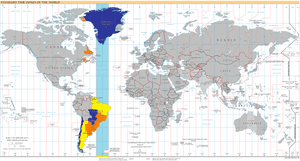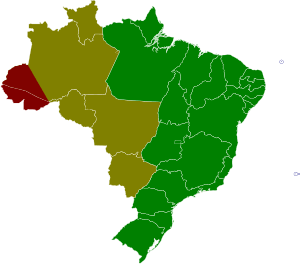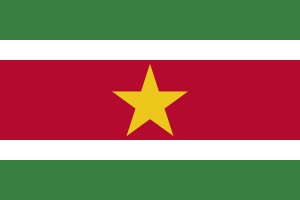UTC−03:00
UTC−03:00 is an identifier for a time offset from UTC of −03:00.
| UTC−03:00 | |
|---|---|
 World map with the time zone highlighted | |
| UTC offset | |
| UTC | UTC−03:00 |
| Current time | |
| 12:48, 16 August 2020 UTC−03:00 [refresh] | |
| Central meridian | |
| 45 degrees W | |
| Date-time group | |
| P | |

UTC−03:00: blue (January), orange (July), yellow (all year round), light blue (sea areas)

Time in Brazil, since April 26, 2019.
| ACT | Acre Time | UTC−5 | (BRT–2) | |
| AMT | Amazon Time | UTC−4 | (BRT−1) | |
| BRT | Brasilia Time | UTC−3 | (BRT) | |
| FNT | Fernando de Noronha Time | UTC−2 | (BRT+1) |
As standard time (Northern Hemisphere winter)
Europe

- Greenland[1]
- Except areas around Danmarkshavn, Ittoqqortoormiit and Pituffik (Thule)
- Greenland[1]

As daylight saving time (Northern Hemisphere summer)
Principal cities: Halifax
North America
.svg.png)
- New Brunswick
- Newfoundland and Labrador
- Labrador
- Except the area between L'Anse-au-Clair and Norman Bay[2]
- Labrador
- Nova Scotia
- Prince Edward Island


As standard time (all year round)
Principal cities: São Paulo, Buenos Aires, Montevideo
South America


- Except the western states of Acre, Amazonas, Mato Grosso, Mato Grosso do Sul, Rondônia and Roraima; and offshore islands





Antarctica
- Some bases on the Antarctic Peninsula and nearby islands. See also Time in Antarctica
As daylight saving time (Southern Hemisphere summer)
Principal cities: Santiago, Asunción
South America


Antarctica
- Some bases on the Antarctic Peninsula and nearby islands. See also Time in Antarctica
Places using UTC−03:00, located outside the 45°W ± 7.5° range
- El Chaltén, Argentina (72°53′W corresponding to UTC−04:51)
- Qaanaaq, Greenland (69°13′W corresponding to UTC−04:37)
- Buenos Aires, Argentina (58°22′W corresponding to UTC−03:53:48)
- Stanley, Falkland Islands (57°51'W corresponding to UTC−03:51:24)
- Uruguaiana, Brazil (57°05'W corresponding to UTC–03:48)
- Montevideo, Uruguay (56°23’W corresponding to UTC-03:44:51)
- Saint Pierre and Miquelon (56°12′W corresponding to UTC−03:44:40)
- Upernavik, Greenland (56°08′W corresponding to UTC−03:44:36)
- Paramaribo, Suriname (55°10′W corresponding to UTC−03:40:40)
- Kulusuk, Greenland (37°11′W corresponding to UTC−02:28)
- Recife, Brazil (34°54′W corresponding to UTC−02:19:36)
Other uses
While Ethiopia officially uses UTC+03:00, Ethiopian culture follows a time system with two 12-hour cycles for day and night, and is 6 hours "slower" than the official time. The day begins with the day cycle at sunrise (6:00 a.m., but designated as 12 o'clock by local rendition) till sunset, followed by the night cycle (official 6:00 p.m., unofficial 12:00 night cycle). Therefore Ethiopia effectively follows UTC-03:00. [5]
gollark: So your vote is to be discounted unless it would reach 25 and actually count?
gollark: We're working with <@509849474647064576> and some other people.
gollark: Project PREDESTINED SPECTRE, as I said.
gollark: Oh, we do.
gollark: BAIDICOOT, UNAPPLY THIS!
See also
References
- "How far is it from Qaanaaq to locations worldwide". timeanddate.com. Retrieved 24 April 2014.
- "Newfoundland-Labrador Time Zone – Newfoundland-Labrador Current Local Time – Daylight Saving Time". TimeTemperature.com. Retrieved 26 October 2012.
- "South America Time Zone Map". TimeTemperature. Retrieved 4 February 2018.
- "Official Time". CHILEAN NAVY HYDROGRAPHIC AND OCEANOGRAPHIC SERVICE. Retrieved 17 June 2019.
- If you have a meeting in Ethiopia, you'd better double check the time, pri.org.
This article is issued from Wikipedia. The text is licensed under Creative Commons - Attribution - Sharealike. Additional terms may apply for the media files.